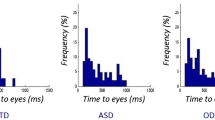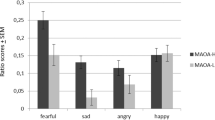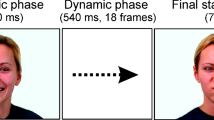Abstract
It has been suggested that atypical emotional face processing strategies observed in autism may extend in milder form to the general population. We investigated the relationship between autistic traits (AT) and gaze behaviour in a neurotypical adult sample. Novel naturalistic videos featuring happy, fearful and neutral faces were first validated in a sample of 22 participants. A separate sample of participants (N = 67) then viewed the three videos in counterbalanced order. Eye-tracking data showed that participants looked longer at emotional than neutral faces, and exploration of facial features varied with emotional condition. AT did not influence viewing patterns, time to first fixation or number of early fixations. We conclude that AT in the general population do not affect visual processing of emotional faces.




Similar content being viewed by others
References
Adolphs, R., Spezio, M. L., Parlier, M., & Piven, J. (2008). Distinct face-processing strategies in parents of autistic children. Current Biology,18(14), 1090–1093.
Ashwin, C., Wheelwright, S., & Baron-Cohen, S. (2006). Attention bias to faces in Asperger Syndrome: A pictorial emotion Stroop study. Psychological Medicine,36(6), 835–843.
Bal, E., Harden, E., Lamb, D., Van Hecke, A. V., Denver, J. W., & Porges, S. W. (2010). Emotion recognition in children with autism spectrum disorders: Relations to eye gaze and autonomic state. Journal of Autism and Developmental Disorders,40(3), 358–370.
Boraston, Z., & Blakemore, S. J. (2007). The application of eye-tracking technology in the study of autism. The Journal of Physiology,581(3), 893–898.
Brosch, T., Sander, D., Pourtois, G., & Scherer, K. R. (2008). Beyond fear: Rapid spatial orienting toward positive emotional stimuli. Psychological Science,19(4), 362–370. https://doi.org/10.1111/j.1467-9280.2008.02094.x.
Calvo, M. G., Nummenmaa, L., & Hyönä, J. (2008). Emotional scenes in peripheral vision: Selective orienting and gist processing, but not content identification. Emotion,8(1), 68.
Chen, F. S., & Yoon, J. M. (2011). Brief report: Broader autism phenotype predicts spontaneous reciprocity of direct gaze. Journal of Autism and Developmental Disorders,41(8), 1131–1134.
Clark, T. F., Winkielman, P., & McIntosh, D. N. (2008). Autism and the extraction of emotion from briefly presented facial expressions: Stumbling at the first step of empathy. Emotion,8(6), 803.
Constantino, J. N., & Todd, R. D. (2003). Autistic traits in the general population: A twin study. Archives of General Psychiatry,60(5), 524–530.
Dawson, G., Toth, K., Abbott, R., Osterling, J., Munson, J., Estes, A., et al. (2004). Early social attention impairments in autism: Social orienting, joint attention, and attention to distress. Developmental Psychology,40(2), 271.
Dawson, G., Webb, S. J., & McPartland, J. (2005). Understanding the nature of face processing impairment in autism: Insights from behavioral and electrophysiological studies. Developmental Neuropsychology,27(3), 403–424.
Dimberg, U., & Petterson, M. (2000). Facial reactions to happy and angry facial expressions: Evidence for right hemisphere dominance. Psychophysiology,37(5), 693–696.
Duque, A., & Vázquez, C. (2015). Double attention bias for positive and negative emotional faces in clinical depression: Evidence from an eye-tracking study. Journal of Behavior Therapy and Experimental Psychiatry,46, 107–114.
Eisenbarth, H., & Alpers, G. W. (2011). Happy mouth and sad eyes: Scanning emotional facial expressions. Emotion,11(4), 860.
Eisenberg, N., & Lennon, R. (1983). Sex differences in empathy and related capacities. Psychological Bulletin,94(1), 100.
Faul, F., Erdfelder, E., Lang, A.-G., & Buchner, A. (2007). G*Power 3: A flexible statistical power analysis program for the social, behavioral, and biomedical sciences. Behavior Research Methods,39, 175–191.
Fletcher-Watson, S., Leekam, S. R., Benson, V., Frank, M. C., & Findlay, J. M. (2009). Eye-movements reveal attention to social information in autism spectrum disorder. Neuropsychologia,47(1), 248–257. https://doi.org/10.1016/j.neuropsychologia.2008.07.016.
Ford, M. E. (1982). Social cognition and social competence in adolescence. Developmental Psychology,18(3), 323.
Gharib, A., Mier, D., Adolphs, R., & Shimojo, S. (2015). Eyetracking of social preference choices reveals normal but faster processing in autism. Neuropsychologia,72, 70–79.
Harms, M. B., Martin, A., & Wallace, G. L. (2010). Facial emotion recognition in autism spectrum disorders: A review of behavioral and neuroimaging studies. Neuropsychology Review,20(3), 290–322. https://doi.org/10.1007/s11065-010-9138-6.
Henderson, J. M. (2003). Human gaze control during real-world scene perception. Trends in Cognitive Sciences,7(11), 498–504.
Hsiao, J. H.-W., & Cottrell, G. (2008). Two fixations suffice in face recognition. Psychological Science,19(10), 998–1006.
Humphrey, K., Underwood, G., & Lambert, T. (2012). Salience of the lambs: A test of the saliency map hypothesis with pictures of emotive objects. Journal of Vision,12(1), 22–22.
Hurley, R. S., Losh, M., Parlier, M., Reznick, J. S., & Piven, J. (2007). The broad autism phenotype questionnaire. Journal of Autism and Developmental Disorders,37(9), 1679–1690.
Jack, R. E., Garrod, O. G. B., & Schyns, P. G. (2014). Dynamic facial expressions of emotion transmit an evolving hierarchy of signals over time. Current Biology,24(2), 187–192. https://doi.org/10.1016/j.cub.2013.11.064.
Jamil, R., Gragg, M. N., & DePape, A.-M. (2017). The broad autism phenotype: Implications for empathy and friendships in emerging adults. Personality and Individual Differences,111, 199–204. https://doi.org/10.1016/j.paid.2017.02.020.
Jobe, L. E., & White, S. W. (2007). Loneliness, social relationships, and a broader autism phenotype in college students. Personality and Individual Differences,42(8), 1479–1489.
Kliemann, D., Dziobek, I., Hatri, A., Steimke, R., & Heekeren, H. R. (2010). Atypical reflexive gaze patterns on emotional faces in autism spectrum disorders. Journal of Neuroscience,30(37), 12281–12287.
Klin, A., Sparrow, S. S., De Bildt, A., Cicchetti, D. V., Cohen, D. J., & Volkmar, F. R. (1999). A normed study of face recognition in autism and related disorders. Journal of Autism and Developmental Disorders,29(6), 499–508.
Komogortsev, O. V., Gobert, D. V., Jayarathna, S., Koh, D. H., & Gowda, S. M. (2010). Standardization of automated analyses of oculomotor fixation and saccadic behaviors. IEEE Transactions on Biomedical Engineering,57(11), 2635–2645.
Lipp, O. V., & Derakshan, N. (2005). Attentional bias to pictures of fear-relevant animals in a dot probe task. Emotion,5(3), 365.
Losh, M., Adolphs, R., Poe, M. D., Couture, S., Penn, D., Baranek, G. T., et al. (2009). Neuropsychological profile of autism and the broad autism phenotype. Archives of General Psychiatry,66(5), 518–526.
Lykins, A. D., Meana, M., & Strauss, G. P. (2008). Sex differences in visual attention to erotic and non-erotic stimuli. Archives of Sexual Behavior,37(2), 219–228.
Mathews, A., Fox, E., Yiend, J., & Calder, A. (2003). The face of fear: Effects of eye gaze and emotion on visual attention. Visual Cognition,10(7), 823–835. https://doi.org/10.1080/13506280344000095.
Miu, A. C., Pană, S. E., & Avram, J. (2012). Emotional face processing in neurotypicals with autistic traits: Implications for the broad autism phenotype. Psychiatry Research,198(3), 489–494.
Niu, Y., Todd, R., & Anderson, A. K. (2012). Affective salience can reverse the effects of stimulus-driven salience on eye movements in complex scenes. Frontiers in Psychology,3, 336.
Noh, S. R., & Isaacowitz, D. M. (2013). Emotional faces in context: Age differences in recognition accuracy and scanning patterns. Emotion,13(2), 238.
Nummenmaa, L., Hietanen, J. K., Santtila, P., & Hyönä, J. (2012). Gender and visibility of sexual cues influence eye movements while viewing faces and bodies. Archives of Sexual Behavior,41(6), 1439–1451.
Öhman, A., & Mineka, S. (2001). Fears, phobias, and preparedness: Toward an evolved module of fear and fear learning. Psychological Review,108(3), 483.
Olsson, P. (2007). Real-time and offline filters for eye tracking.
Pelphrey, K. A., Sasson, N. J., Reznick, J. S., Paul, G., Goldman, B. D., & Piven, J. (2002). Visual scanning of faces in autism. Journal of Autism and Developmental Disorders,32(4), 249–261.
Pilarczyk, J., & Kuniecki, M. (2014). Emotional content of an image attracts attention more than visually salient features in various signal-to-noise ratio conditions. Journal of Vision,14(12), 4–4.
Piven, J., & Benjamin, J. (2002). Genetics of personality: The example of the broad autism phenotype. In J. Benjamin, R. P. Ebstein, & R. H. Belmaker (Eds.), Molecular genetics and the human personality (pp. 43–62). Washington: American Psychiatric Press.
Proverbio, A. M. (2017). Sex differences in social cognition: The case of face processing. Journal of neuroscience research,95(1–2), 222–234.
Rutherford, M. D., & Towns, A. M. (2008). Scan path differences and similarities during emotion perception in those with and without autism spectrum disorders. Journal of Autism and Developmental Disorders,38(7), 1371–1381. https://doi.org/10.1007/s10803-007-0525-7.
Ruzich, E., Allison, C., Smith, P., Watson, P., Auyeung, B., Ring, H., et al. (2015). Measuring autistic traits in the general population: A systematic review of the Autism-Spectrum Quotient (AQ) in a nonclinical population sample of 6,900 typical adult males and females. Molecular Autism,6(1), 2.
Sasson, N. J., Nowlin, R. B., & Pinkham, A. E. (2013). Social cognition, social skill, and the broad autism phenotype. Autism,17(6), 655–667.
Shic, F., Chawarska, K., Bradshaw, J., & Scassellati, B. (2008). Autism, eye-tracking, entropy. Paper presented at the 7th IEEE International Conference on Development and Learning.
Swanson, M. R., & Siller, M. (2014). Brief report: Broad autism phenotype in adults is associated with performance on an eye-tracking measure of joint attention. Journal of Autism and Developmental Disorders,44(3), 694–702.
Swanson, M. R., Serlin, G. C., & Siller, M. (2013). Broad autism phenotype in typically developing children predicts performance on an eye-tracking measure of joint attention. Journal of Autism and Developmental Disorders,43(3), 707–718.
Uono, S., Sato, W., & Toichi, M. (2014). Reduced representational momentum for subtle dynamic facial expressions in individuals with autism spectrum disorders. Research in Autism Spectrum Disorders,8(9), 1090–1099.
Vabalas, A., & Freeth, M. (2016). Brief report: Patterns of eye movements in face to face conversation are associated with autistic traits: Evidence from a student sample. Journal of Autism and Developmental Disorders,46(1), 305–314.
Valla, J., Maendel, J., Ganzel, B., Barsky, A., & Belmonte, M. K. (2013). Autistic trait interactions underlie sex-dependent facial recognition abilities in the normal population. Frontiers in Psychology,4, 286.
Van Der Geest, J. N., Kemner, C., Verbaten, M. N., & Van Engeland, H. (2002). Gaze behavior of children with pervasive developmental disorder toward human faces: A fixation time study. Journal of Child Psychology and Psychiatry,43(5), 669–678.
Wagner, J. B., Hirsch, S. B., Vogel-Farley, V. K., Redcay, E., & Nelson, C. A. (2013). Eye-tracking, autonomic, and electrophysiological correlates of emotional face processing in adolescents with autism spectrum disorder. Journal of Autism and Developmental Disorders,43(1), 188–199.
Wainer, A. L., Block, N., Donnellan, M. B., & Ingersoll, B. (2013). The Broader Autism Phenotype and Friendships in Non-clinical Dyads. Journal of Autism and Developmental Disorders,43(10), 2418–2425. https://doi.org/10.1007/s10803-013-1789-8.
Wallace, G. L., Case, L. K., Harms, M. B., Silvers, J. A., Kenworthy, L., & Martin, A. (2011). Diminished sensitivity to sad facial expressions in high functioning autism spectrum disorders is associated with symptomatology and adaptive functioning. Journal of Autism and Developmental Disorders,41(11), 1475–1486.
Wells, L. J., Gillespie, S. M., & Rotshtein, P. (2016). Identification of emotional facial expressions: Effects of expression, intensity, and sex on eye gaze. PLoS ONE,11(12), e0168307.
Werling, D. M., & Geschwind, D. H. (2013). Sex differences in autism spectrum disorders. Current Opinion in Neurology,26(2), 146.
Author information
Authors and Affiliations
Contributions
CG and ES developed the study concept and design. CG collected the data for Experiment 1 and ES collected the data for Experiment 2. All authors contributed to the data analysis. CG wrote the manuscript, with assistance from YK and based in part on an undergraduate thesis written by ES.
Corresponding author
Additional information
Publisher's Note
Springer Nature remains neutral with regard to jurisdictional claims in published maps and institutional affiliations.
Rights and permissions
About this article
Cite this article
Greene, C.M., Suess, E. & Kelly, Y. Autistic Traits Do Not Affect Emotional Face Processing in a General Population Sample. J Autism Dev Disord 50, 2673–2684 (2020). https://doi.org/10.1007/s10803-020-04375-w
Published:
Issue Date:
DOI: https://doi.org/10.1007/s10803-020-04375-w




